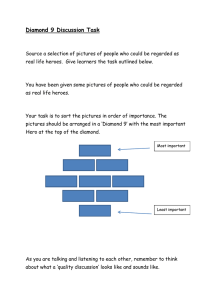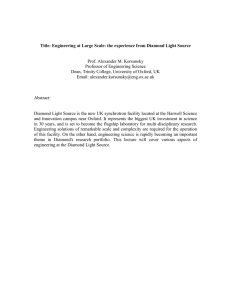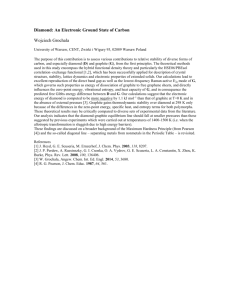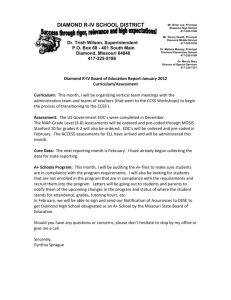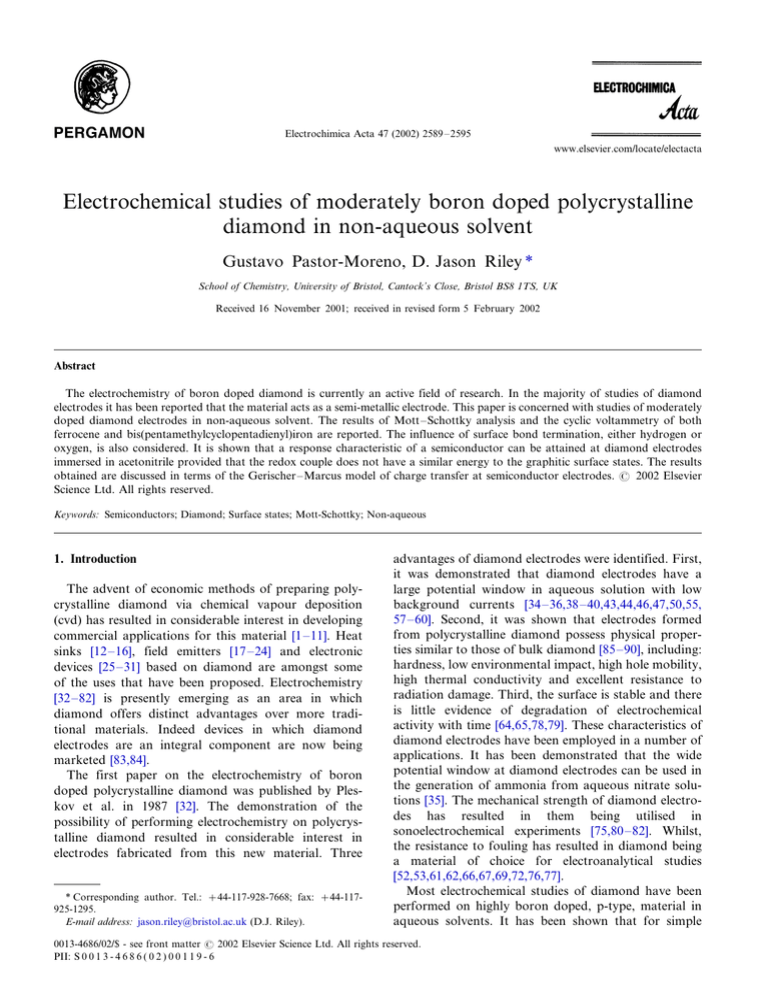
Electrochimica Acta 47 (2002) 2589 /2595
www.elsevier.com/locate/electacta
Electrochemical studies of moderately boron doped polycrystalline
diamond in non-aqueous solvent
Gustavo Pastor-Moreno, D. Jason Riley *
School of Chemistry, University of Bristol, Cantock’s Close, Bristol BS8 1TS, UK
Received 16 November 2001; received in revised form 5 February 2002
Abstract
The electrochemistry of boron doped diamond is currently an active field of research. In the majority of studies of diamond
electrodes it has been reported that the material acts as a semi-metallic electrode. This paper is concerned with studies of moderately
doped diamond electrodes in non-aqueous solvent. The results of Mott /Schottky analysis and the cyclic voltammetry of both
ferrocene and bis(pentamethylcyclopentadienyl)iron are reported. The influence of surface bond termination, either hydrogen or
oxygen, is also considered. It is shown that a response characteristic of a semiconductor can be attained at diamond electrodes
immersed in acetonitrile provided that the redox couple does not have a similar energy to the graphitic surface states. The results
obtained are discussed in terms of the Gerischer /Marcus model of charge transfer at semiconductor electrodes. # 2002 Elsevier
Science Ltd. All rights reserved.
Keywords: Semiconductors; Diamond; Surface states; Mott-Schottky; Non-aqueous
1. Introduction
The advent of economic methods of preparing polycrystalline diamond via chemical vapour deposition
(cvd) has resulted in considerable interest in developing
commercial applications for this material [1 /11]. Heat
sinks [12 /16], field emitters [17 /24] and electronic
devices [25 /31] based on diamond are amongst some
of the uses that have been proposed. Electrochemistry
[32 /82] is presently emerging as an area in which
diamond offers distinct advantages over more traditional materials. Indeed devices in which diamond
electrodes are an integral component are now being
marketed [83,84].
The first paper on the electrochemistry of boron
doped polycrystalline diamond was published by Pleskov et al. in 1987 [32]. The demonstration of the
possibility of performing electrochemistry on polycrystalline diamond resulted in considerable interest in
electrodes fabricated from this new material. Three
* Corresponding author. Tel.: 44-117-928-7668; fax: 44-117925-1295.
E-mail address: jason.riley@bristol.ac.uk (D.J. Riley).
advantages of diamond electrodes were identified. First,
it was demonstrated that diamond electrodes have a
large potential window in aqueous solution with low
background currents [34 /36,38 /40,43,44,46,47,50,55,
57 /60]. Second, it was shown that electrodes formed
from polycrystalline diamond possess physical properties similar to those of bulk diamond [85 /90], including:
hardness, low environmental impact, high hole mobility,
high thermal conductivity and excellent resistance to
radiation damage. Third, the surface is stable and there
is little evidence of degradation of electrochemical
activity with time [64,65,78,79]. These characteristics of
diamond electrodes have been employed in a number of
applications. It has been demonstrated that the wide
potential window at diamond electrodes can be used in
the generation of ammonia from aqueous nitrate solutions [35]. The mechanical strength of diamond electrodes has resulted in them being utilised in
sonoelectrochemical experiments [75,80/82]. Whilst,
the resistance to fouling has resulted in diamond being
a material of choice for electroanalytical studies
[52,53,61,62,66,67,69,72,76,77].
Most electrochemical studies of diamond have been
performed on highly boron doped, p-type, material in
aqueous solvents. It has been shown that for simple
0013-4686/02/$ - see front matter # 2002 Elsevier Science Ltd. All rights reserved.
PII: S 0 0 1 3 - 4 6 8 6 ( 0 2 ) 0 0 1 1 9 - 6
2590
G. Pastor-Moreno, D.J. Riley / Electrochimica Acta 47 (2002) 2589 /2595
redox couples in aqueous solution the electrochemical
response at a diamond electrode resembles that of a
metal electrode [43,51,70,73]. Further, it has been
illustrated that the rate of electron transfer reaction is
dependent up on whether the surface is hydrogen or
oxygen terminated [38,71]. It has been suggested that the
valance band edge at hydrogen terminated diamond
electrode lies at a greater energy than the aqueous H /
H2 couple, this would result in hydrogen terminated
diamond always being in accumulation when in an
aqueous electrolyte [74]. Thus any applied potential
would be dropped across the Helmholtz layer and
reversible electrochemical behaviour observed for simple
redox couples. Indeed an accumulation of holes at a
hydrogen terminated diamond surface exposed to the
atmosphere has been used to explain the enhanced
surface
conductivity
of
the
material
[33,37,41,42,45,48,49,54,56,63,91]. At an oxygen terminated diamond surface reversible electron transfer
occurs at potentials at which Mott /Schottky analysis
suggests the surface is in depletion. Impedance studies
[71,74] indicate that electron transfer at an oxygen
terminated diamond surface occurs via surface states
[38,71,74]. It has been postulated that sp2 carbon surface
impurities mediate the charge transfer.
In this paper we report electrochemical studies of
moderately doped diamond electrodes in non-aqueous
solvents. The use of acetonitrile as a solvent permits the
hydrogen terminated diamond electrode to be studied at
potentials at which holes do not accumulate at the
electrode surface. In addition it allows redox couples to
be employed that exhibit low overlap integrals with the
graphitic surface states. It is demonstrated that in nonaqueous solvents diamond electrodes can show behaviour characteristic of a semiconducting material.
2. Experimental
Boron doped nanocrystalline diamond films were
deposited on a 1.5 cm2 undoped silicon (100) wafer by
hot-filament cvd. Prior to the deposition process, the
substrate was manually abraded with 1 /3 mm diamond
grit and then ultrasonically cleaned in propan-2-ol. The
silicon was then placed in a hot-filament reactor
containing a mixture of hydrogen, methane and diborane at a pressure of 20 Torr. Typical flow rates during
deposition were 200 sccm of H2, 1.4 sccm of CH4 and
4 /105 sccm of B2H6, corresponding to a boron to
carbon ration of 50 ppm in the gas phase. Deposition of
the polycrystalline diamond film was achieved by
activating the gas phase with hot-filaments, two 0.25
mm diameter tantalum coils in series. The deposition
time was 16 h, giving a film thickness of approximately 5
mm. The film was allowed to cool in the hydrogen
atmosphere before removal from the chamber. A TiC
ohmic contact was formed to permit electrochemical
investigations of the as-prepared low doped samples.
Before electrochemical studies the boron doped diamond films were characterised using Raman spectroscopy (Renishaw confocal imaging systems) and
scanning electron microscopy (SEM) (JEOL JSM
5600LV).
It has been established that the surface of hot-filament
cvd diamond is hydrogen terminated [92]. In order to
ensure hydrogen termination was maintained samples
were stored under vacuum. To generate oxygen terminated surfaces the diamond electrodes were immersed in
a hot chromic acid solution [41,93]. It is noted that this
procedure resulted in a considerable reduction in the
surface conductivity of the film [94 /96].
All electrochemical experiments were performed in a
dry box in which the amount of water vapour was less
than 6 ppm by volume. In the experiments anhydrous
acetonitrile (99.9% pure) was used as solvent and 0.1
mol dm 3 tetrabutylammonium perchlorate (TBAP) as
supporting electrolyte. Cyclic voltammetric studies were
performed on solution containing 1/103 mol dm 3
of either ferrocene (FeCp2) or bis(pentamethylcyclopentadienyl)iron (FeCp2 ). A three electrode system was
employed; a boron doped diamond working electrode, a
platinum gauze counter electrode and a FeCp2/FeCp2
reference electrode. All potentials are reported relative
to FeCp2/FeCp2 couple. The diamond electrode was
mounted in the cell such that 0.4 cm2 of the diamond
surface was exposed to electrolyte. Impedance measurements were performed using a Solartron 1286 potentiostat and a Solartron 1250 frequency response analyser;
the instruments were controlled using Z -plot software.
In all ac experiments a modulation amplitude of 10 mV
was applied. Cyclic voltammetry measurements were
performed using a EG&G 273 Princeton Applied
Research instrument that was controlled using Research
Electrochemistry software.
3. Results and discussion
The quality of the polycrystalline boron doped
diamond films was analysed using Raman spectroscopy
and sem. The Raman spectrum, shown in Fig. 1,
displays a sharp peak at 1332 cm 1 corresponding to
sp3 hybridised carbon. There is no evidence of sp2 peaks
between 1500 and 1700 cm 1 indicating that the film
has a low graphitic content. This conclusion is supported by the sem image, shown in Fig. 2, in which
amorphous regions associated with the presence of
graphitic carbon are not observed. The film consists of
crystals of dimension approximately 1 /5 mm and
appears continuous across the entire substrate.
To establish the position of the band edges of p-type
diamond in acetonitrile Mott /Schottky analyses were
G. Pastor-Moreno, D.J. Riley / Electrochimica Acta 47 (2002) 2589 /2595
Fig. 1. Raman spectrum of boron doped diamond film grown by hotfilament cvd. Spectrum shows sharp crystalline diamond band at 1332
cm 1.
Fig. 2. Scanning electron micrograph of the morphology of a high
quality boron doped diamond electrode.
undertaken. Plots of 1/(capacitance)2 against applied
potential, recorded at different frequencies, for both
hydrogenated and oxygenated boron doped diamond
electrodes immersed in acetonitrile containing 0.1 mol
dm 3 TBAP are displayed in Fig. 3 and Fig. 4.
Although Mott/Schottky theory suggests that the plots
should be independent of the measuring frequency this
behaviour is rarely observed for semiconductor electrodes. Surface roughness, dielectric relaxation and the
influence of surface states have all been advanced as
explanations of the frequency dispersion in Mott /
Schottky plots [97]. Using the data recorded at a
frequency of 10 kHz a free carrier concentration of
1.1 /1018 cm3 was determined for both the hydrogenated and oxygenated sample. This figure compares
favourably with the experimental conditions employed
during film preparation; a boron to carbon ratio of 50
ppm in the gas phase suggests a boron density of 5.7 /
1018 cm 3 in the crystal.
2591
Fig. 3. Mott /Schottky plots for semiconducting hydrogen terminated
boron doped diamond electrode Three frequencies of modulation were
recorded; ^ 10 KHz,k 5 KHz and I 1 KHz. Linear extrapolation of
the experimental data has a common intercept approximately 0.8 V.
Potential relative to the ferrocene standard redox couple.
Fig. 4. Mott /Schottky plots for semiconducting oxygen terminated
boron doped diamond electrode Three frequencies of modulation were
recorded; 2 20 KHz, k 10 KHz and I 5 KHz. Linear extrapolation
of the experimental data has a common intercept approximately 1.5 V.
Potential relative to the ferrocene standard redox couple.
At the hydrogenated surface the Mott /Schottky plots
are linear between /1.8 and /4.0 V and possess a
common intercept. The plots indicate that the valence
band edge, relative to the ferrocene couple, lies at
/0.8 V. Given that the band gap of diamond is 5.4
eV [98] this places the conduction band edge at /6.2 V
on the same scale, or at /1.3 eV relative to an electron
in a vacuum [99]. The fact that hydrogen terminated
diamond has a negative electron affinity is one of the
key reasons why this material is being considered in field
emission devices [17 /24].
The change in surface bond polarisation at the oxygen
terminated surface relative to the hydrogenated surface
results in a large shift in the band edges [71]. This is
evident in the Mott /Schottky data for the oxygenated
p-type diamond electrode. In the case of the oxygenated
diamond surface a linear region is observed between 0.3
and /2.0 V; as for the hydrogen terminated surface
2592
G. Pastor-Moreno, D.J. Riley / Electrochimica Acta 47 (2002) 2589 /2595
frequency dispersion is evident but a common intercept
is attained. Analysis of the data indicates that for an
oxygen terminated p-type diamond electrode in acetonitrile the valence band edge lies at 1.5 V and the
conduction band edge at /3.9 V [100], indicating a
positive electron affinity.
In Fig. 5 the energy levels for the oxygen and
hydrogen terminated surfaces of p-type diamond, as
determined from the Mott /Schottky data, are shown.
In addition the energy levels of some outer sphere redox
couples are displayed [101,102]. To facilitate discussion
the electron affinity of graphitic carbon is also plotted,
this energy level is a guide to the energy of graphitic
surface states at the diamond/electrolyte interface [99].
In Fig. 6 cyclic voltammograms for hydrogen and
oxygen surface terminated diamond in both 1 /10 3
mol dm 3 FeCp2 and 1 /103 mol dm 3 FeCp2 are
displayed. It is apparent that the redox behaviour of the
electrodes is highly dependent on the surface termination.
At the hydrogen terminated surface, Fig. 6a, well
defined oxidation and reduction peaks are observed for
the FeCp2/FeCp2 redox couple. The cathodic peak is
distorted and the peak separation is approximately 1.2
V; it should be noted that the material was highly
resistive, no iR compensation was employed when
recording the voltammograms, and the kinetics of the
redox couple appears to be slow. In contrast Fig. 6b
shows that the oxidation of FeCp2 at the same surface is
irreversible with negligible cathodic currents until voltages less than /2.5 V are achieved. This behaviour is
explained in terms of the classical Marcus /Gerischer
mechanism of electron transfer [103]. Reference to Fig. 5
indicates that the redox level of the FeCp2/FeCp2
couple lies within the valence band of the hydrogen
terminated p-type diamond. Hence at the redox potential of the couple the Fermi level lies within a semiconductor band and reversible electrochemistry is
observed. In comparison the redox level of the
FeCp2 /FeCp2 couple lies within the band gap of the
hydrogen terminated p-type diamond. Therefore, an
anodic current flows only at potentials under which
holes accumulate at the electrode surface whilst a small
constant cathodic current flows due to the negligible
overlap between the energy levels of the oxidised states
and the valence band edge. At high negative overpotentials an increased cathodic current may be observed due to breakdown of the Schottky barrier. In
summary the results indicate that the hydrogen terminated material is acting as a p-type semiconductor
electrode when used in non-aqueous solvents.
The large shift in the band edges with change in
surface termination of p-type diamond results in the
cyclic voltammograms recorded at the oxygen terminated surface being markedly different to those of the
hydrogen terminated surface. The cyclic voltammogram
in Fig. 6c indicates that for the FeCp2/FeCp2 couple
anodic and cathodic currents are observed at the
oxygenated surface. The current magnitude is considerably less than that for the hydrogenated surface despite
identical experimental parameters. In Fig. 6d the cyclic
voltammogram for the FeCp2 /FeCp2 couple is displayed, it is apparent that this couple is inactive within
the potential window of the solvent. The energy levels
that are shown in Fig. 5 indicate that both redox couples
investigated are situated between the band edges of the
oxygen terminated surface. The observation that FeCp2
is not oxidised indicates that in the potential range of
interest the p-type oxygenated diamond surface is in
depletion and not inversion. It is, therefore, difficult to
justify the anodic peak observed in the FeCp2 voltammogram simply in terms of direct charge transfer
between the valence band of the material and the redox
couple. In studies of oxygenated p-type diamond
electrochemistry involving aqueous electrolytes evidence
for surface state mediated charge transfer has been
observed [38,71,74]. It has been suggested that the
surface states involved in the charge transfer are
graphitic in character. The results reported above
support this proposal. Fig. 5 indicates that the FeCp2
couple is close in energy to graphitic states whilst the
FeCp2 redox couple lies at greater energy than the
surface states. This indicates that graphitic state
mediated charge transfer will be facile for the FeCp2
couple but difficult for the FeCp2 couple, as observed.
4. Conclusions
Fig. 5. Proposed energy diagram for the diamond-electrolyte interface
for hydrogen and oxygen terminated samples.
Studies of moderately boron doped diamond in nonaqueous solvents have permitted the influence of surface
termination on the electrochemical behaviour of this
semiconductor to be investigated. It was shown that the
surface termination is important in two respects. First, it
determines the position of the band edges. These may
shift by approximately 2.3 V on going from an oxygen
terminated to a hydrogen terminated surface. Second,
G. Pastor-Moreno, D.J. Riley / Electrochimica Acta 47 (2002) 2589 /2595
2593
Fig. 6. Cyclic voltammetric i /E curves recorded at a scan rate of 0.1 V s 1, of boron doped diamond electrodes. (a) A hydrogen terminated sample
immersed in 1 10 3 mol dm3 FeCp2. (b) A hydrogen terminated sample immersed in 1 10 3 mol dm 3 FeCp2 . (c) An oxygen terminated
sample immersed in 1 10 3 mol dm 3 FeCp2. (d) An oxygen terminated sample immersed in 1 10 3 mol dm 3 FeCp2. All potentials are related
to the ferrocene standard redox couple.
graphitic surface states may mediate charge transfer.
For the hydrogen terminated diamond surface the
electrochemical studies in non-aqueous solvent showed
characteristics of a non-degenerately doped p-type
semiconducting material, to the authors’ knowledge
this is the first time such behaviour has been observed
for a non-oxidised diamond electrode. For the oxygen
terminated surface it was demonstrated that reversible
cyclic voltammograms are only observed for redox
couples of comparable energy to graphitic surface
states.
Acknowledgements
The support of the EPSRC (GR/L84308) is gratefully
acknowledged. We thank Dr. S. Davis and P. Hawes for
help in preparing the SEM images.
References
[1] J.C. Angus, H.C. Will, W.S. Stanko, J. Appl. Phys. 39 (1968)
2915.
[2] D.J. Poferl, N.C. Gadner, J.C. Angus, J. Appl. Phys. 44 (1973)
1418.
[3] B.V. Deryagin, B.V. Spytsyn, L.L. Builov, A.A. Klochov, A.E.
Gorodetskii, A.V. Smolyanimov, Dokl. Akad. Nauk. SSSR 231
(1976) 333.
[4] B.V. Spitsyn, L.L. Bouilov, B.V. Derjaguin, J. Cryst. Growth 52
(1981) 219.
[5] S. Matsumoto, Y. Sato, M. Tsutsumi, N. Setaka, J. Mater. Sci.
17 (1982) 3106.
[6] S. Matsumoto, Y. Sato, M. Kamo, N. Setaka, Jpn. J. Appl.
Phys. Part 2-Lett. 21 (1982) L183.
[7] M. Kamo, Y. Sato, S. Matsumoto, N. Setaka, J. Cryst. Growth
62 (1983) 642.
[8] Y. Saito, S. Matsuda, S. Nogita, J. Mater. Sci. Lett. 5 (1986) 565.
[9] P.W. May, N.M. Everitt, C.G. Trevor, M.N.R. Ashfold, K.N.
Rosser, Appl. Surf. Sci. 68 (1993) 299.
[10] N.A. Fox, S. Mary, T.J. Davis, W.N. Wang, P.W. May, A.
Bewick, J.W. Steeds, J.E. Butler, Diam. Relat. Mater. 6 (1997)
1135.
2594
G. Pastor-Moreno, D.J. Riley / Electrochimica Acta 47 (2002) 2589 /2595
[11] J.R. Petherbridge, P.W. May, S.R.J. Pearce, K.N. Rosser,
M.N.R. Ashfold, J. Appl. Phys. 89 (2001) 1484.
[12] C.T. Troy, Photon. Spect. 26 (1992) 28.
[13] G. Lu, Applications of Diamond Films and Related Materials:
2nd International Conference, 1993, Tokio.
[14] P.J. Boudreaux, Applications of Diamond Films and Related
Materials: 3rd International Conference, 1995, Washington, DC.
[15] E. Worner, C. Wild, W. Mullersebert, R. Locher, P. Koidl,
Diam. Relat. Mater. 5 (1996) 688.
[16] K.L. Jackson, D.L. Thurston, P.J. Boudreaux, R.W. Armstrong,
C.C.M. Wu, J. Mater. Sci. 32 (1997) 5035.
[17] F.J. Himpsel, J.A. Knapp, J.A. Van Vechten, D.E. Eastman,
Phys. Rev. B 20 (1979) 624.
[18] M.W. Geis, J.A. Gregory, B.B. Pate, IEEE T. Electron Dev. 38
(1991) 619.
[19] M.W. Geis, N.N. Efremow, J.D. Woodhouse, M.D. Mcaleese,
M. Marchywka, D.G. Socker, J.F. Hochedez, IEEE Electr.
Device L 12 (1991) 456.
[20] J. Ishikawa, H. Tsuji, Y. Gotoh, T. Sasaki, T. Kaneko, M.
Nagao, K. Inoue, J. Vac. Sci. Technol. B 11 (1993) 403.
[21] N.A. Fox, W.N. Wang, T.J. Davis, J.W. Steeds, P.W. May,
Appl. Phys. Lett. 71 (1997) 2337.
[22] P.W. May, S. Hohn, W.N. Wang, N.A. Fox, Appl. Phys. Lett.
72 (1998) 2182.
[23] P.W. May, S. Hohn, M.N.R. Ashfold, W.N. Wang, N.A. Fox,
T.J. Davis, J.W. Steeds, J. Appl. Phys. 84 (1998) 1618.
[24] P.W. May, M.T. Kuo, M.N.R. Ashfold, Diam. Relat. Mater. 8
(1999) 1490.
[25] C.E. Troupe, I.C. Drummond, C. Graham, J. Grice, P. John,
J.I.B. Wilson, M.G. Jubber, N.A. Morrison, Diam. Relat.
Mater. 7 (1998) 575.
[26] W. Haenni, H. Baumann, C. Comninellis, D. Gandini, P.
Niedermann, A. Perret, N. Skinner, Diam. Relat. Mater. 7
(1998) 569.
[27] A. Mainwood, Diam. Relat. Mater. 7 (1998) 504.
[28] H.J. Looi, L.Y.S. Pang, M.D. Whitfield, J.S. Foord, R.B.
Jackman, Diam. Relat. Mater. 8 (1999) 966.
[29] A.R. Mahon, J.H. Macdonald, A. Mainwood, R.J. Ott, Diam.
Relat. Mater. 8 (1999) 1748.
[30] S. Ertl, M. Adamschik, P. Schmid, P. Gluche, A. Floter, E.
Kohn, Diam. Relat. Mater. 9 (2000) 970.
[31] E. Kohn, M. Adamschik, P. Schmid, S. Ertl, A. Floter, Diam.
Relat. Mater. 10 (2001) 1684.
[32] Y.V. Pleskov, A.Y. Sakharova, M.D. Krotova, L.L. Bouilov,
B.P. Spitsyn, J. Electroanal. Chem. 228 (1987) 19.
[33] S.A. Grot, G.S. Gildenblat, C.W. Hatfield, C.R. Wronski, A.R.
Badzian, T. Badzian, R. Messier, IEEE Electr. Device L 11
(1990) 100.
[34] G.M. Swain, R. Ramesham, Anal. Chem. 65 (1993) 345.
[35] R. Tenne, K. Patel, K. Hashimoto, A. Fujishima, J. Electroanal.
Chem. 347 (1993) 409.
[36] G. Swain, Adv. Mater. 6 (1994) 388.
[37] J. Vanderweide, R.J. Nemanich, Phys. Rev. B 49 (1994) 13629.
[38] S. Alehashem, F. Chambers, J.W. Strojek, G.M. Swain, R.
Ramesham, Anal. Chem. 67 (1995) 2812.
[39] J.W. Strojek, M.C. Granger, G.M. Swain, T. Dallas, M.W.
Holtz, Anal. Chem. 68 (1996) 2031.
[40] F. Bouamrane, A. Tadjeddine, J.E. Butler, R. Tenne, C. LevyClement, J. Electroanal. Chem. 405 (1996) 95.
[41] H. Kawarada, Surf. Sci. Rep. 26 (1996) 205.
[42] H. Kiyota, H. Okushi, T. Ando, M. Kamo, Y. Sato, Diam.
Relat. Mater. 5 (1996) 718.
[43] H.B. Martin, A. Argoitia, U. Landau, A.B. Anderson, J.C.
Angus, J. Electrochem. Soc. 143 (1996) L133.
[44] Y.V. Pleskov, V.V. Elkin, M.A. Abaturov, M.D. Krotova, V.Y.
Mishuk, V.P. Varnun, I.G. Teremetskaya, J. Electroanal. Chem.
413 (1996) 105.
[45] J. Shirafuji, T. Sugino, Diam. Relat. Mater. 5 (1996) 706.
[46] N. Vinokur, B. Miller, Y. Avyigal, R. Kalish, J. Electrochem.
Soc. 143 (1996) L238.
[47] R. Declements, G.M. Swain, J. Electrochem. Soc. 144 (1997)
856.
[48] K. Hayashi, H. Watanabe, S. Yamanaka, T. Sekiguchi, H.
Okushi, K. Kajimura, Diam. Relat. Mater. 6 (1997) 303.
[49] T.P. Humphreys, R.E. Thomas, D.P. Malta, J.B. Posthill, M.J.
Mantini, R.A. Rudder, G.C. Hudson, R.J. Markunas, C.
Pettenkofer, Appl. Phys. Lett. 70 (1997) 1257.
[50] L.F. Li, S. Totir, B. Miller, G. Chottiner, A. Argoitia, J.C.
Angus, D. Scherson, J. Am. Chem. Soc. 119 (1997) 7875.
[51] R. Ramesham, M.F. Rose, Diam. Relat. Mater. 6 (1997) 17.
[52] Y.N. Shi, A.F. Slaterbeck, C.J. Seliskar, W.R. Heineman, Anal.
Chem. 69 (1997) 3679.
[53] Y.N. Shi, C.J. Seliskar, W.R. Heineman, Anal. Chem. 69 (1997)
4819.
[54] L. Diederich, O. Kuttel, P. Aebi, L. Schlapbach, Surf. Sci. 418
(1998) 219.
[55] C.H. Goeting, F. Jones, J.S. Foord, J.C. Eklund, F. Marken,
R.G. Compton, P.R. Chalker, C. Johnston, J. Electroanal.
Chem. 442 (1998) 207.
[56] P.W. May, J.C. Stone, M.N.R. Ashfold, K.R. Hallam, W.N.
Wang, N.A. Fox, Diam. Relat. Mater. 7 (1998) 671.
[57] Z.Y. Wu, T. Yano, D.A. Tryk, K. Hashimoto, A. Fujishima,
Chem. Lett. (1998) 503.
[58] T. Yano, D.A. Tryk, K. Hashimoto, A. Fujishima, J. Electrochem. Soc. 145 (1998) 1870.
[59] R. Ramesham, Thin Solid Films 315 (1998) 222.
[60] F. Beck, H. Krohn, W. Kaiser, M. Fryda, C.P. Klages, L.
Schafer, Electrochim. Acta 44 (1998) 525.
[61] G.M. Swain, A.B. Anderson, A.J.C. Angus, MRS Bulletin
(1998) 56.
[62] R. Tenne, C. Levy-Clement, Israel J. Chem. 38 (1998) 57.
[63] L. Diederich, P. Aebi, O.M. Kuttel, L. Schlapbach, Surf. Sci. 424
(1999) L314.
[64] R. Ramesham, Thin Solid Films 339 (1999) 82.
[65] M.C. Granger, J.S. Xu, J.W. Strojek, G.M. Swain, Anal. Chim.
Acta 397 (1999) 145.
[66] A.F. Slaterbeck, T.H. Ridgway, C.J. Seliskar, W.R. Heineman,
Anal. Chem. 71 (1999) 1196.
[67] M.D. Koppang, M. Witek, J. Blau, G.M. Swain, Anal. Chem. 71
(1999) 1188.
[68] S. Nakabayashi, N. Ohta, A. Fujishima, PCCP 1 (1999) 3993.
[69] T.N. Rao, I. Yagi, T. Miwa, D.A. Tryk, A. Fujishima, Anal.
Chem. 71 (1999) 2506.
[70] T. Yano, E. Popa, D.A. Tryk, K. Hashimoto, A. Fujishima, J.
Electrochem. Soc. 146 (1999) 1081.
[71] J. Van De Lagemaat, D. Vanmaekelbergh, J.J. Kelly, J.
Electroanal. Chem. 475 (1999) 139.
[72] J.S. Xu, G.M. Swain, Anal. Chem. 71 (1999) 4603.
[73] F.J. Del Campo, C.H. Goeting, D. Morris, J.S. Foord, A.
Neudeck, R.G. Compton, F. Marken, Electrochem. Solid St. 3
(2000) 224.
[74] M.N. Latto, D.J. Riley, P.W. May, Diam. Relat. Mater. 9 (2000)
1181.
[75] A.J. Saterlay, S.J. Wilkins, C.H. Goeting, J.S. Foord, R.G.
Compton, F. Marken, J. Solid State Electr. 4 (2000) 383.
[76] B.V. Sarada, T.N. Rao, D.A. Tryk, A. Fujishima, Anal. Chem.
72 (2000) 1632.
[77] Y.V. Pleskov, J. Anal. Chem. 55 (2000) 1045.
[78] P.L. Hagans, P.M. Natishan, B.R. Stoner, W.E. O’grady, J.
Electrochem. Soc. 148 (2001) E298.
[79] J. Iniesta, P.A. Michaud, M. Panizza, G. Cerisola, A. Aldaz, C.
Comninellis, Electrochim. Acta 46 (2001) 3573.
[80] A.J. Saterlay, S.J. Wilkins, K.B. Holt, J.S. Foord, R.G.
Compton, F. Marken, J. Electrochem. Soc. 148 (2001) E66.
G. Pastor-Moreno, D.J. Riley / Electrochimica Acta 47 (2002) 2589 /2595
[81] F.J. Del Campo, A. Neudeck, R.G. Compton, F. Marken, S.D.
Bull, S.G. Davies, J. Electroanal. Chem. 507 (2001) 144.
[82] J.D. Wadhawan, F.J. Del Campo, R.G. Compton, J.S. Foord,
F. Marken, S.D. Bull, S.G. Davies, D.J. Walton, S. Ryley, J.
Electroanal. Chem. 507 (2001) 135.
[83] D. Gandini, E. Mahe, P.A. Michaud, W. Haenni, A. Perret, C.
Comninellis, J. Appl. Electrochem. 30 (2000) 1345.
[84] S. Ferro, A. De Battisti, I. Duo, C. Comninellis, W. Haenni, A.
Perret, J. Electrochem. Soc. 147 (2000) 2614.
[85] J.C. Angus, C.C. Hayman, Science 241 (1988) 913.
[86] P.K. Bachmann, R. Messier, Chem. Eng. News 67 (1989) 24.
[87] M.W. Geis, J.C. Angus, Sci. Am. 267 (1992) 84.
[88] R.F. Davis, J. Cryst. Growth 137 (1994) 161.
[89] M.W. Geis, J.C. Angus, Sci. Am. 270 (1994) 10.
[90] R. Ramesham, D.C. Hill, S.R. Best, M.F. Rose, R.F. Askew,
Thin Solid Films 257 (1995) 68.
[91] K. Hayashi, S. Yamanaka, H. Watanabe, T. Sekiguchi, H.
Okushi, K. Kajimura, J. Appl. Phys. 81 (1997) 744.
[92] P.W. May, Phil. Trans. R. Soc. Lond. A 358 (2000) 473.
2595
[93] Y. Mori, H. Kawarada, A. Hiraki, Appl. Phys. Lett. 58 (1991)
940.
[94] M.I. Landstrass, K.V. Ravi, App. Phys. Lett. 55 (1989) 975.
[95] M.I. Landstrass, K.V. Ravi, App. Phys. Lett. 55 (1989)
1391.
[96] B.J. Lee, B.T. Ahn, J.K. Lee, Y.J. Baik, Diam. Relat. Mater. 10
(2001) 2147.
[97] W.P. Gomes, F. Cardon, Prog. Surf. Sci. 12 (1982) 155.
[98] F. Maier, M. Riedel, B. Mantel, J. Ristein, L. Ley, Phys. Rev.
Lett. 85 (2000) 3472.
[99] S.R. Morrison, Electrochemistry at Semiconductor and Oxidized
Metal Electrodes, Plenum Press, 1980.
[100] P.K. Baumann, S.P. Bozeman, B.L. Ward, R.J. Nemanich,
Diam. Relat. Mater. 6 (1997) 398.
[101] N.G. Connelly, W.E. Geiger, Chem. Rev. 96 (1996) 877.
[102] D.R. Lide, In: D.R. Lide (Ed.) CRC Handbook of Chemistry
and Physics; 75 edn.; 1994; pp Section 8 page 20.
[103] A.J. Bard, L.R. Faulkner, Electrochemical Methods: Fundamentals and Applications, second ed., Wiley, 2001.

